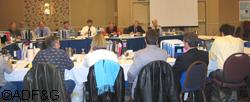Alaska Fish & Wildlife News
December 2006
Public Input to Fish and Game Policy:
The Joint Board

The Joint Board plays an important role at The Alaska Department of Fish and Game and in the next year the group will be addressing important issues regarding the advisory committee system in Alaska.
Advisory committees are the grass roots organizations that discuss fish and wildlife management and provide recommendations to the boards on changes to the regulations. There are 81 committees throughout Alaska, each with expertise in the surrounding area.
The first Alaska State Legislature established the fish and game advisory committee system in 1959, recognizing the value of local knowledge in regards to fish and game resources in Alaska. The advisory committee system provides a conduit between department staff, local user groups, and both the Alaska Board of Fisheries and the Board of Game. At your local advisory committee meeting, you often find a Department of Fish and Game biologist exchanging ideas with local hunters and fishermen as well as a warm cup of coffee and some great stories.
The Joint Boards of Fisheries and Game established the advisory committees and set the guidelines and uniform rules of operation.
The Joint Board is exactly what it sounds like: a confluence of the Board of Game and the Board of Fisheries. When Alaska assumed management of its fish and wildlife resources in 1960, a single Board of Fisheries and Game was created to regulate the harvest of these resources. The boards were separated in 1975 after the legislature recognized the complexities of managing Alaska’s fish and wildlife resources. Since the separation, the 14 members of the two boards meet jointly for various reasons including the commissioner selection process for the Department of Fish and Game, to review and set regulations concerning the non-subsistence areas of the state and the functioning of the advisory committee system.
“The board met in March of this year to address regulations concerning membership qualifications for advisory committees,” said Kristy Tibbles, the executive director for the Board of Game. “They also met for the commissioner selection process in 2005 when McKie Cambell was selected.”
The new governor has the option to retain or replace Fish and Game commissioners, and if she doesn’t retain Campbell, the joint board will meet.

“They don’t select the new commissioner, but they will forward her a list of names for consideration,” Tibbles said.
Before that, the last time the Joint Board met to address regulatory issues was 1998. The next regulatory meeting is scheduled for October, probably in Anchorage, to consider proposals addressing the size and location of advisory committees and the rules of operation.
“They are particularly interested in proposals that will enhance the effectiveness of the advisory committee system,” Tibbles said.
For example, the Joint Board will consider options to consolidate committees where multiple committees represent the same geographic area or share in the use of the same fish stocks and game populations; where committees have been inactive for two or more years; or where a change in committee structure would better facilitate resolving resource issues at the local level before coming to the boards.
The Joint Board will also review the “Non-subsistence” areas of the state which are currently Ketchikan, Juneau, Anchorage-Matsu-Kenai, Fairbanks, and Valdez. The current non-subsistence areas were established in 1992, as required by the State subsistence law. When considering proposed changes to the existing areas the board will need to identify any significant new information since 1992 and address specific socio-economic characteristics.
The Joint Board will use a two step approach with the non-subsistence area review. The October 2007 meeting will be used as a preliminary review to perform an initial assessment of the proposals. The board will then identify any additional information which may be needed and submit the proposals for further public review and departmental analysis prior to regulatory action to take place at a meeting in 2008.
For more information on the Joint Boards of Fisheries and Game upcoming meeting, see: http://www.adfg.alaska.gov/index.cfm?adfg=process.jointboard
Scott Crass works at the Alaska Department of Fish and Game as a member of the Boards Support team, which provides technical and logistical support to the two boards to help them operate effectively and efficiently.
Subscribe to be notified about new issues
Receive a monthly notice about new issues and articles.
